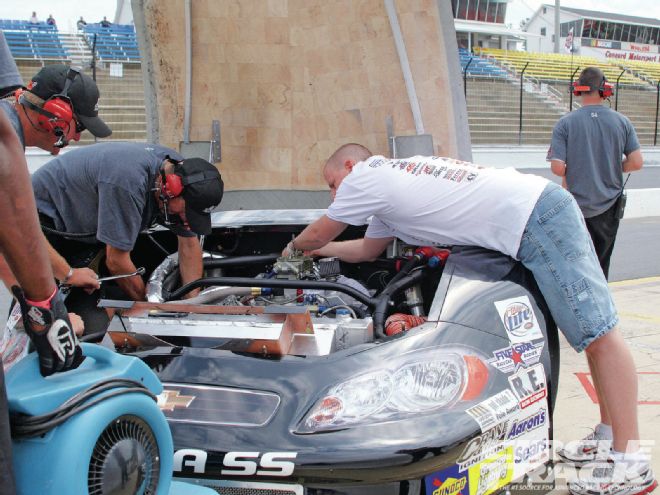
Engine
No matter if you are racing a four-cylinder in a Mini Stock class or a no-holds-barred, alcohol-burning V-8 Super Late Model, all stock car racing engines work on the same principles. And one of the most critical is that it's up to your carburetor to provide the proper mixture of air and atomized fuel to maximize power.
When your engine builder handed over your race engine, it was optimized to the absolute best performance under a given set of conditions. Of course, those conditions are always what is found in the dyno room that day. But at the racetrack there's no way to control temperature, humidity, altitude, barometric pressure, and a host of other things. If those conditions don't match those on the day your engine was tuned on the dyno, you may be down on power.
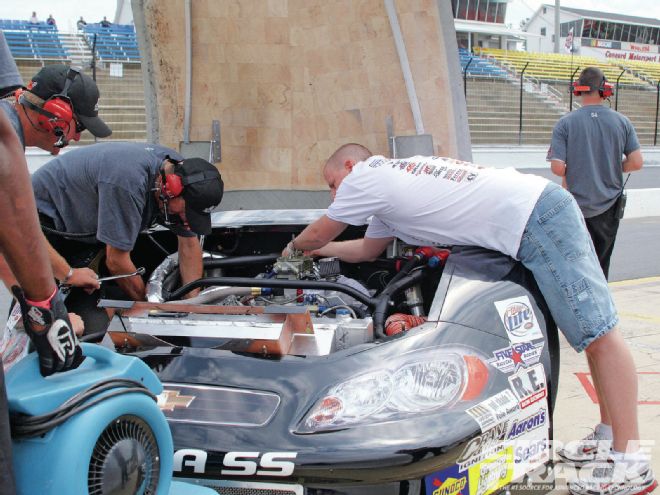 Automotive Specialists’ Jeff Dorton makes a carburetor tuning change to this Pro Cup car during a practice session while a crewmember also works on the suspension.
Automotive Specialists’ Jeff Dorton makes a carburetor tuning change to this Pro Cup car during a practice session while a crewmember also works on the suspension.
This is why being able to properly tune your race engine at the track is so critical. NASCAR Sprint Cup teams keep a person on staff to handle the tuning duties, but most of us simply can't afford that luxury. Dedicated engine builders will often spend their weekends visiting different racetracks to support their customers, but what happens if your builder isn't at the track that day? Then it's up to you to make sure your engine is at least close to peak power.
To find out more, we spent a Saturday shadowing Keith and Jeff Dorton of race engine builder Automotive Specialists at a CARS Pro Cup race. As the owner of Automotive Specialists, Keith Dorton has built the engines powering multiple champions in the Pro Cup Series, and he regularly follows the series to support his customers at the racetrack. The track-tuning practices he's developed are certainly proven to work, and he was willing to share them with us. And as long as you're racing a carbureted engine, the same principles should work for you.
Before Practice
No matter if you call it practice or hot laps, before you hit the track for the first time there are a few things that should always be done. Some can be taken care of before you leave your shop if you prefer, but a few should always be done just before you leave the pits.
"The first thing to be done is just to make a visual inspection of the car," Dorton says. "Make sure nothing looks wrong. Check the belts to make sure the tension is good and there isn't excessive wear. You should also look over the plug wires to make sure they haven't been touching the headers and have spots that are melted. Plug wires can take a lot of heat, but if you see spots where the insulation is melted or turned black from touching the headers, you should probably go ahead and consider changing them."
Next, fire the engine up and check the timing. Check both the timing at idle speed and at race rpm. If you're running a mechanical advance, make sure the mechanism advances the timing consistently when you rev the motor. If you have the advance locked out, make sure the timing doesn't change as you rev the motor.
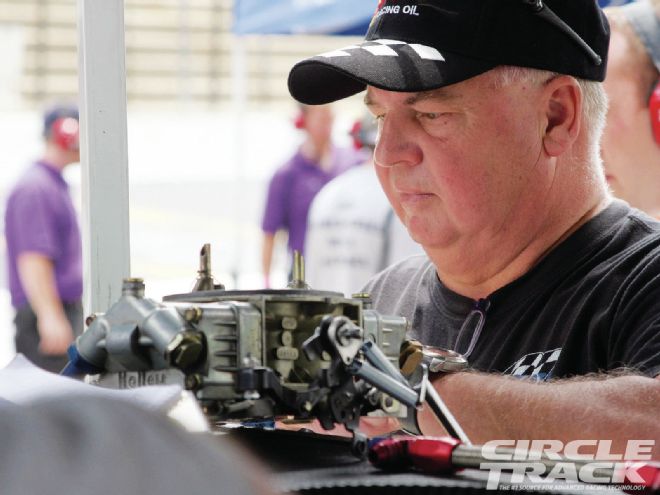 Keith Dorton, owner of Automotive Specialists, reminds racers not to get too caught up in spending practice time chasing small carburetor changes. As long as the engine isn’t down on power, the best way to whittle down your lap times is by perfecting your suspension setup.
Keith Dorton, owner of Automotive Specialists, reminds racers not to get too caught up in spending practice time chasing small carburetor changes. As long as the engine isn’t down on power, the best way to whittle down your lap times is by perfecting your suspension setup.
During Practice
During practice, Dorton says he generally tries to stay out of the way. And he cautions car owners not to waste too much of their practice time experimenting with different carburetor settings. Instead, concentrate on the areas that have the potential to give you the biggest speed gains. "You're going to get a lot more out of a sway bar change than you will a jet change," he explains.
In other words, chassis adjustments can make a major difference in lap times when you're trying to find the optimum setup during practice, while an engine-tuning change--unless something is really wrong--generally won't result in a major difference in lap times. The biggest reason to make something like a carb tuning change during practice is if the carburetor isn't functioning properly, or there's a driveability issue. Since practice time is valuable, concentrate on getting the best-handling race car possible and don't allow the little things to distract your focus.
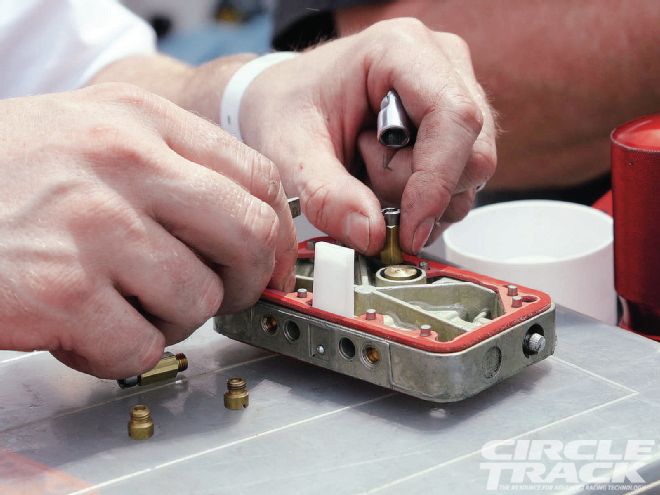 High-g turns can sometimes cause the fuel in the float bowls to slosh away from the secondaries. You can use extensions, like you see here, to move the pickups toward the rear of the bowl.
High-g turns can sometimes cause the fuel in the float bowls to slosh away from the secondaries. You can use extensions, like you see here, to move the pickups toward the rear of the bowl.
Of course, if your race car is significantly off the lap times the leaders are producing, you're going to have to figure out the source of the trouble. Is it a chassis problem, or is the engine down on power? That's a debate between engine builders and chassis specialists that's raged for decades, and it likely won't be going away any time soon.
One of the best ways to determine if your car's slower times are a result of a problem with the engine or chassis is with the stopwatch. Start comparing times between your driver and the fastest cars on the track. But don't time complete laps. Instead, start clocking segments. First, compare your driver's times to the fastest cars just through Turns 1 and 2. Then do the same thing through Turns 3 and 4. Finally, compare your driver to the leaders through the straights. Pick a point to begin timing where most cars have straightened out and the drivers are just getting to full throttle, and stop at the point where most drivers are just getting out of the throttle.
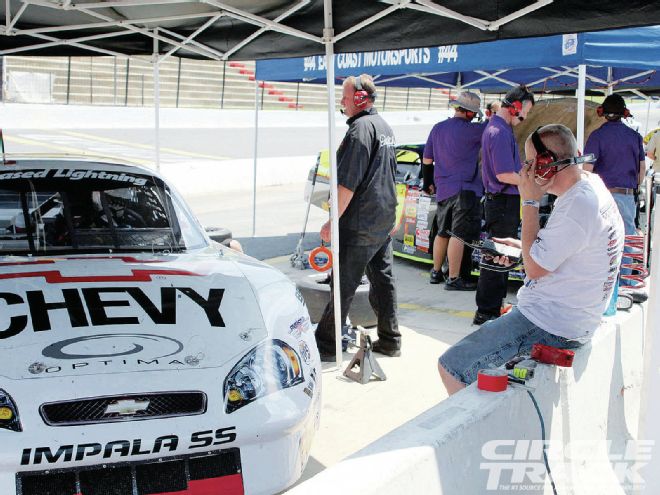 You should always keep in good communication with your driver because he or she is the only one in the driver seat. Make sure to have your driver monitor the water and oil temps and pressures during practice. He or she should also provide feedback on how the engine feels, which not only includes a seat-of-the-pants perspective, but also what is heard as well as if there are any unusual vibrations.
You should always keep in good communication with your driver because he or she is the only one in the driver seat. Make sure to have your driver monitor the water and oil temps and pressures during practice. He or she should also provide feedback on how the engine feels, which not only includes a seat-of-the-pants perspective, but also what is heard as well as if there are any unusual vibrations.
If the biggest difference between your driver and the fastest cars' times is in the turns, then you should begin looking for a chassis problem. After all, every engine produces the same amount of power when the carburetor's throttle blades are closed. There's probably some problem hindering your driver from getting through the turns cleanly. But if the biggest loss of time came on the straights, then you may have an engine that's down on power. Just make sure to always look at the big picture. If handling is so poor on turn exit that your driver is picking up the throttle later than the competition, then his straightaway speeds are obviously going to be lower too.
Dorton also cautions that there are a few ways that a poorly adjusted carburetor can cause your car to be slow through the turns--particularly a turn exit. Fuel sloshing in the carburetor can cause the engine to stumble or bog a bit when the driver picks up the throttle, especially on high-grip tracks where there is strong side-loading.
You may also want to keep an eye on your float levels if you notice a stumble or hesitation through the turns. If you have the float level too low, high-g turns can sometimes cause the left-side secondaries to become uncovered. This is especially true on the rear of the carburetor where fuel can not only be pushed to the right side of the float bowl, but also the rear as the driver accelerates out of the turn. In situations like this, you may have to raise the float level a bit.
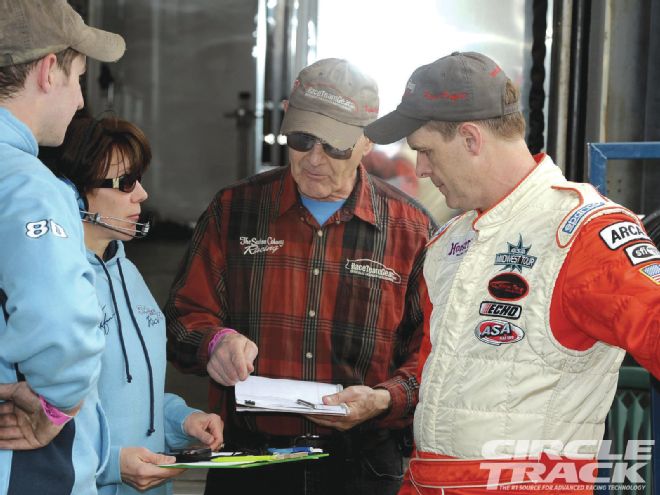 Good communication follows beyond just talking to the driver while he or she is sitting in the car, a discussion of all the notes taken during practice is essential to creating a winning formula.
Good communication follows beyond just talking to the driver while he or she is sitting in the car, a discussion of all the notes taken during practice is essential to creating a winning formula.
On the front of the carburetor, you may also have to deal with spillover if you're able to get the forward bite maximized for very hard accelerations. If the float level in the front is too high, the fuel can actually spill over into the vent tubes. This time around you may need to lower the float level.
Often, it can be hard to determine exactly what carburetor adjustments need to be made. And since practice time is limited, you don't have time to be making a bunch of different changes. When you're trying to determine the best change to make, Dorton suggests going ahead and making your changes in big steps. This way your driver should be able to tell you exactly what the change did to the car's performance. Either it helped performance or it hurt it. You may have to go back and tone down the adjustment a bit, but at least you won't be wasting time with tuning changes that are too small to really let you know which way you need to go.
After Practice
After practice is complete, Dorton recommends performing another visual inspection. Again, you're checking the belts for wear, oil and coolant leaks, burned plug wires, and anything else that might be amiss. Dorton also makes it a habit to talk to the driver just to get his opinion on the state of the engine. Ask him or her how the engine responded to throttle inputs, if everything sounded OK, and if he noticed any vibrations. He or she should also be able to tell you how hot the oil and water temps got during the run.
"The absolute last thing I want to do between practice and the start of the race," Dorton adds, "is have to change the plugs. You want to avoid installing any new plugs at all costs right before a race, because you just don't know if you are going to get a bad plug. You won't discover it until the race starts, and then it's too late. I encourage teams to keep a set of plugs on hand that they ran some laps on during a test session. That way, you know they're all good."
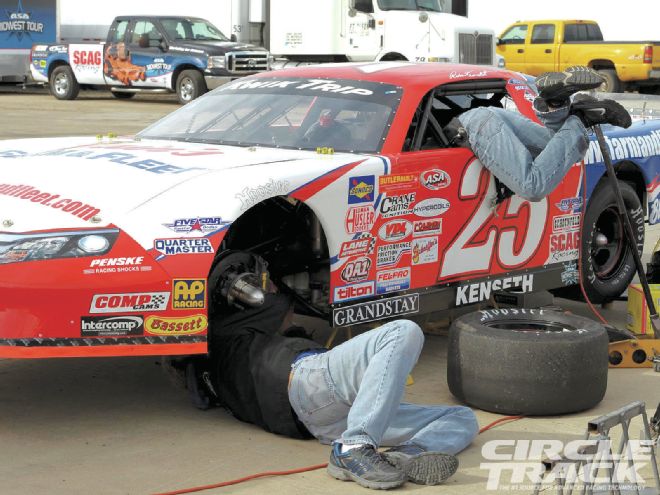 Granted, these guys are not tuning on the engine or carb, but having multiple team members is a major help in getting numerous tasks done simultaneously as you can see Ross Kenseth’s crew doing here.
Granted, these guys are not tuning on the engine or carb, but having multiple team members is a major help in getting numerous tasks done simultaneously as you can see Ross Kenseth’s crew doing here.
If you get water or oil temps that are higher than usual, and the cooling system seems to be in working order, you should check to make sure the engine isn't going lean. Often, this isn't a jetting problem, but a problem with fuel delivery instead. Check that the fuel filter isn't clogged, there are no leaks in the fuel lines, the fuel pump is working properly, and the pickup in the fuel cell hasn't moved.
A quick visual inspection of the tailpipes is also a good way to get an idea of how the engine is running. Dorton says he usually carries a flashlight to help him see inside the tailpipes as far as possible, but as long as you can see approximately 12 inches up the exit of the pipe you should be fine. If all is well, the inside of the pipe should be light chocolate color. The color is from the carbon deposits from the exhaust. If it's white or ashy, that's a sign the engine is running too lean. If it's dark or excessively sooty, then you're probably running too rich. Sooty pipes can also signal a blown power valve. If they're oily, that's a sign you may have a ring sealing problem.
One area that often leaves many engine tuners barking up the wrong tree is trying to read plugs at a short track. Dorton says that there is simply too much idling and off throttle driving that it contaminates the porcelain on the plug and makes an accurate read too difficult. "Plus," he adds, "to get a good read, you need to do a clean shut off, where the driver kills the engine while at full throttle. But most Saturday night short tracks aren't set up for green-flag pit stops like you're used to seeing in NASCAR's Sprint Cup Series. The entrance to pit road is often tight with very sharp curves, and cars can't coast all the way to the pits. It's just too dangerous to ask a driver to do a clean shut off at most short tracks."
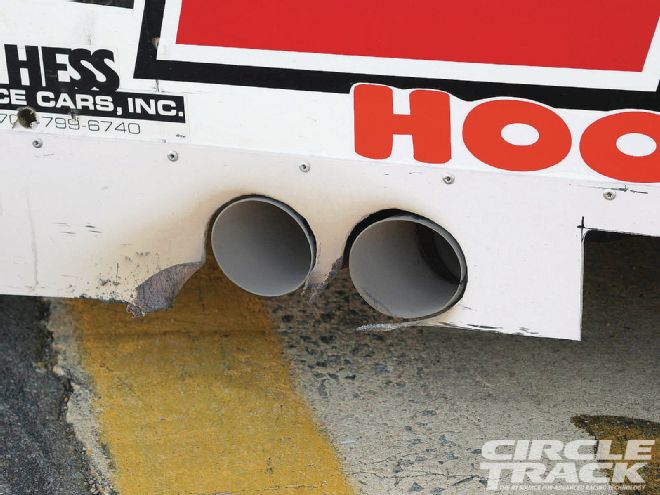 The tailpipes are a good indicator of how the engine is running. Dorton says they should be a light chocolate color approximately 12 inches inside the pipe. Too light means a likely lean condition, while too dark can mean a blown power valve or a carburetor that’s running too rich.
The tailpipes are a good indicator of how the engine is running. Dorton says they should be a light chocolate color approximately 12 inches inside the pipe. Too light means a likely lean condition, while too dark can mean a blown power valve or a carburetor that’s running too rich.
What you can do, however, is keep an eye on how much heat the plug is seeing. The farther the heat ring travels up the plug, the more heat your engine is seeing. This is something that changes from engine to engine, so you'll have to get an idea how heat discolors the plugs on your engine. But, for example, if you pull a couple plugs after practice and notice that the heat ring extends all the way up the threads of the plug, it's a sign that your engine may be running too lean.
Use these tips as guidelines to ensure that your engine is in top shape when you get to the track. Remember to always be thorough in your inspections and keep detailed notes.